Once you’ve hunted with your own dog, you’re spoiled forever. Our sport becomes much more rewarding when you do it with a partner and buddy you trained yourself. While starting from scratch with a puppy and learning how to train a hunting dog can seem like a daunting task for a first-timer, the truth is, the dog is born knowing how to hunt. Your first job as a trainer is to not screw it up. You second job is teaching the dog to hunt for you. If you’re like most dog owners, another important part of training is turning your pup into a well-mannered member of the family whose company you can enjoy in the off-season as well.
This isn’t a journey to start lightly. During the puppy stage, dogs are both unbearably cute and also just unbearable at times, not to mention destructive. Owning a dog requires a commitment of a decade or more. During those years, it means more time in the field so your dog can gain experience, and less time for you to sit in a tree stand. And no matter how long the journey lasts, it is guaranteed to end in tears. The only way you’ll feel better is by starting the cycle all over again with a new pup. That’s what you’re in for, but believe me, it’s all worth it. Right now, though, you’re getting your first gun dog. Congratulations! Below is everything you need to know about how to train a hunting dog. So, let’s get started.
Table of Contents
Choosing a Puppy
10 Things You Need to Know
House and Crate Training
Potty Training
Obedience and Socialization
Puppy Kinderkarten
How to Train a Dog for the Field
How to Teach “Fetch”
How to Teach “Whoa”
How to Teach “Place”
Introduction to Water
Introduction to Live Birds
Whether to Use an E-Collar
Introduction to the Gun
Your First Hunts Together
**Related: The 21 Best Hunting Dog Breeds Ever
**
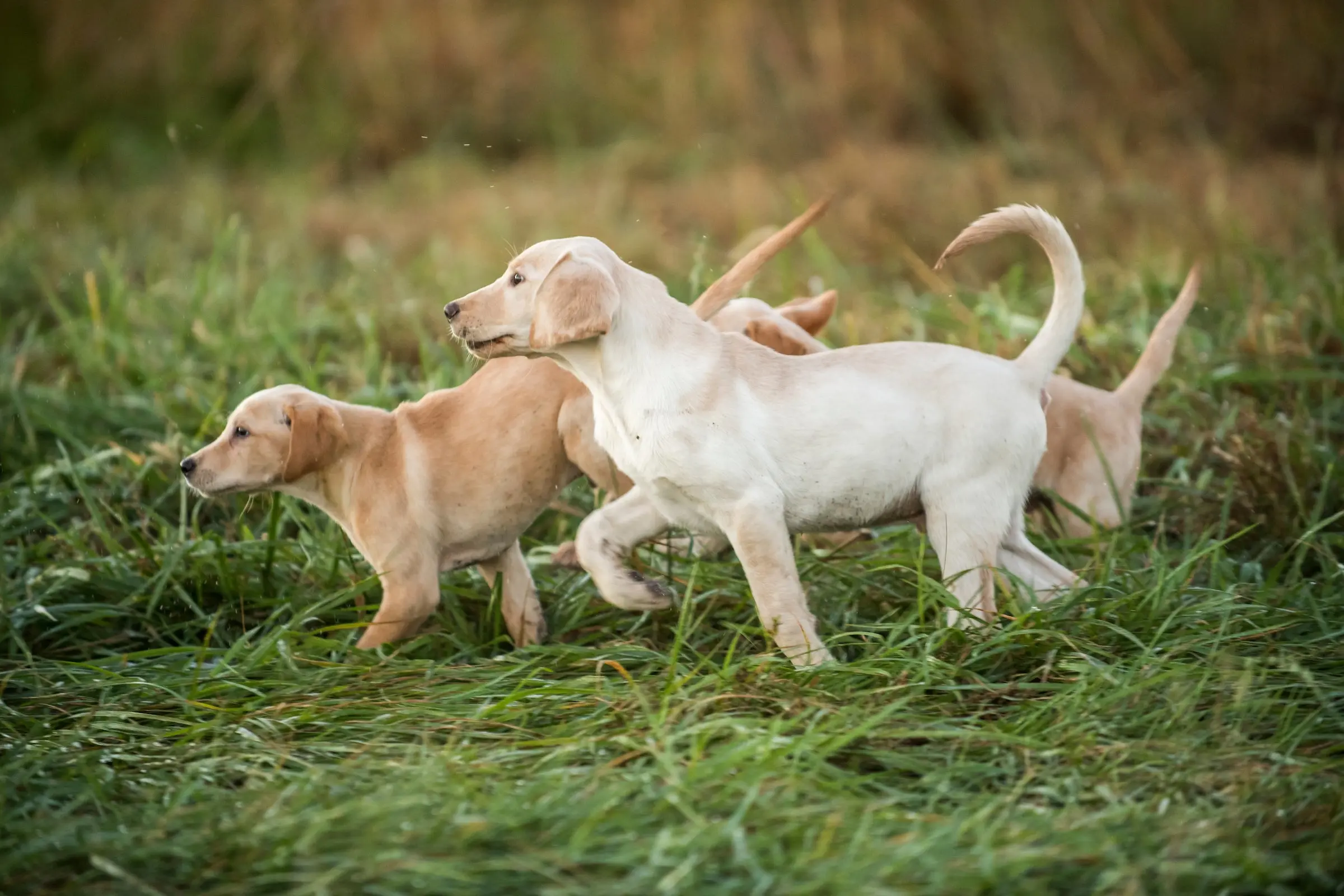
Decide on the breed of dog you want, then spend the money to get a dog from a good breeder. John Hafner Photography
Once you decide on a breed that suits the type of hunting you’ll do, find a kennel. Research your breeder. You not only want a dog from hunting stock, you want one that hunts the way you want it to. While there are plenty of stories about barnyard mutts or nonhunting breeds that showed up the fancy purebreds, going cheap on a puppy is a roll of the dice that I don’t recommend.
Instead, spend the money on a dog from a good breeder. Yes, you’ll write a hefty check, but believe me, that is a small fraction of the money you’ll spend as a dog owner over the next dozen years, and an investment in a good dog will simplify your job as a novice trainer. A dog from good field bloodlines is hard-wired to hunt. As a trainer admitted to me once, “All you have to do with a dog like that is teach it its name, teach it to come when called, and take it hunting.” You’ll want to do more than that, in fact, but if you start with the right puppy, you’ve got a great head start.
Do your research. Breeders emphasize different traits. A setter bred for field trials will run and range, while another setter from grouse hunting stock will naturally hunt much closer. If you can watch the dam and sire hunt, you’ll have a better idea of what you’re getting. And that can make a big difference. For instance, my first dog was free. The price was right, and the dog was a German shorthair, a breed reputed to hunt close. However, Sam came from field trial stock. He loved to run. As a first-time trainer, I had years of frustration until I finally got his range under control.
While you research your breeder, don’t be offended if they research you. In fact, that’s a good thing. Good breeders want their dogs to go to an owner who will care for them and hunt them. Also, the good breeders usually have a waiting list. Get on it. It will be worth the wait. If possible, find a litter born in the late winter or early spring. You’ll get your puppy in April or May, and that’s good for two reasons: First, you’ll be outside a lot, often in the middle of the night, early on, and that’s easier in mild weather. Second, your puppy will be six months old or so when hunting seasons open, and it will be ready to hunt.
How to Train a Dog: 10 Things You Need to Know
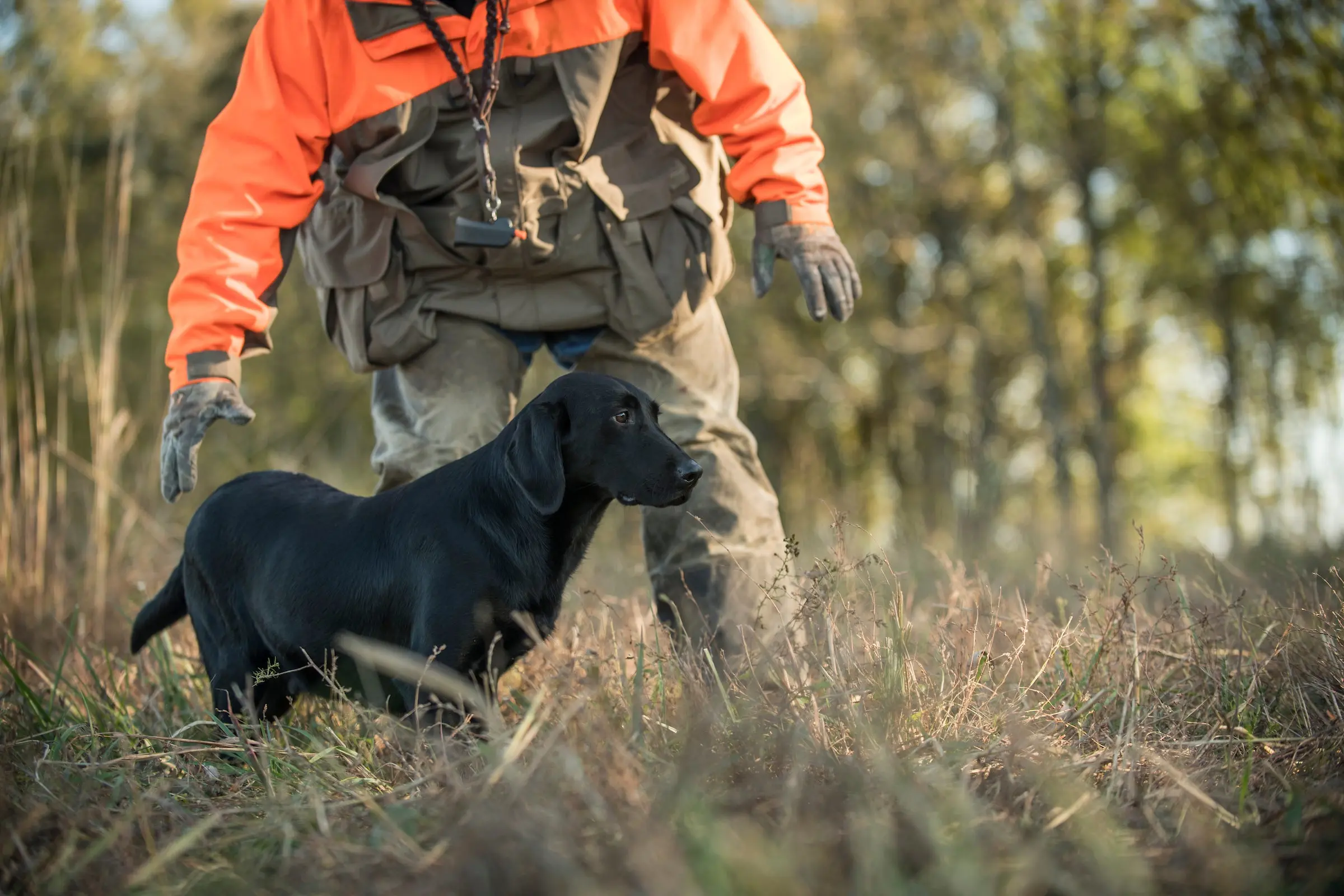
As your pup gets older, training will get more intense.
The old joke goes: What you need to know to train a dog? Answer: More than the dog. That’s not exactly true, though. The dog knows how to hunt better than you do. That’s why you bought it. What you need to know is how to teach that dog to hunt for you. First lessons can start as soon as the puppy comes home. Keep them brief and fun. As the pup gets older, you do more, and training never stops. Here are 10 important points to help guide you along the way no matter what kind of dog you’re training.
1. Be Consistent
Dogs want to please you, and in order to do that, they have to understand what you want from them. Be clear and consistent in your commands.
2. Reward Good Behavior
Praise is a powerful motivator. Your dog wants your attention, so give it to them when the deserve it.
3. Train with Treats
Food is an even more powerful motivator than praise. Even the reward of a small piece of kibble will motivate your dog.
4. Mean What You Say
Never give commands you won’t or can’t enforce. This goes back to No. 1 because part of being consistent is always being able to back up what you say. Think before you speak.
5. Keep It Short
Make your training sessions brief and frequent. Start each training with behaviors your pup already knows to get her attention. Try to end on a good note, and quit while you’re having fun. Training might last a few minutes or it might last half an hour or longer.
6. Never Stop
Dogs will always test boundaries. You must always enforce them and be in charge. For instance, never let a dog go through a door before you do. Make it wait for you to go first. Don’t let it carry its own leash on walks. It’s cute, but it’s the dog trying to be control. You have to be the leader of the pack. Take advantage of any opportunity you can to reinforce desired behaviors, or teach new ones.
7. Avoid Negative Attention
Don’t give attention to unwanted behaviors. Ignoring things like barking or rushing to the front door when the bell rings is sometimes a more effective way to curtail them than yelling. Likewise, if a dog is frightened by something, picking it up and comforting it reinforces that behavior. It’s better to act as if nothing is wrong and distract the puppy.
8. Act Fast
Discipline only works if it’s an immediate consequence. Dogs do not reason, nor do they remember. If a dog runs off and you yell when it finally comes back, all it has learned is that you yell when it comes back. You have to discipline dogs in the act.
9. Be Patient
Dog training takes time, and you often have to progress gradually in tiny steps. You can set yourself back a long way by pushing too hard.
10. Don’t Train Angry
Training a hunting dog can be frustrating. Remember, the dog is only being a dog. If it’s not doing what you want, that’s on you, the trainer. Don’t take that out on the dog.
How to Train a Dog: House and Crate Training
Ideally your new dog comes home at 8 to 10 weeks. It’s still a baby, but you can start its training right away. The very first lessons are house- and crate-training. You want the crate to be a happy place for your dog. If you have to encourage them to get into the crate with a toy or a treat or even feeding them in the crate, do it. Start giving the command “kennel up” when you do. My two dogs respond to the command “take naps” now and will hurry eagerly into their boxes to lie down.
Don’t use the crate as punishment, although you can absolutely use it as a place to keep dogs out of the way when you have company. Their association with the crate should always be positive. A crate is not only a dog’s own den at home, it’s the safest way to transport a dog in a vehicle, too, so it’s important that your dog learns to love it.
Potty Training
House training goes along with crate training. A puppy won’t make a mess in its own den (unless you leave it in too long), so you use the crate as a starting point for house training. Take your puppy outside regularly, especially after eating or playing, or when you get it out of the crate. Eventually you’ll develop a feel for when the dog needs to go out, and you can scoop the pup up and head for the backyard. The dog will learn to wait by the door and ask to go out. Praise you pup when it eliminates outside. You can also try a command like “potty.” A friend who was a long-haul traveling wingshooter liked “be quick,” which he believed encouraged the dog to hurry up during rest stops on cold road trips.
Obedience and Socialization
Simple obedience begins right away. Be encouraging, praise lavishly, and remember that if you want a puppy to come, you have to act like you are where the party is. The dog will come. Make a big deal over it when it does. Small dog treats work wonders, too. Keep everything light, happy, and fun. You will occasionally need to discipline your dog. Do it firmly, as gently as possible, and only if you catch the dog in the act. There’s no reason to hit a dog. Tell you pup “No!” and then remove it from the scene and ignore it for a while.
The more situations you can put your puppy in with people, new things, and other dogs, the better. Take it easy though, and watch the puppy carefully to gauge its reactions. Remember that if it shows fear and you pick it up and comfort it, you’re reinforcing the behavior. It’s better to act as if nothing is wrong and distract the puppy if possible. Also, while a tired puppy is the best kind of puppy, don’t overdo your early outings or activities. Their little joints are growing and cannot stand much pounding, jumping out of things, or long runs.
Puppy Kindergarten
You can teach basic obedience yourself. You can also sign up for a puppy kindergarten class where the dog not only learns new things, but will also meets other dogs and their owners. The classes start well dogs are around four months old. I always looked forward to classes because I knew my puppy would learn something, and I knew it would be worn out afterward. A kindergarten class led by a trainer is a much better place for your puppy to meet other dogs than a dog park, which you should avoid early on. Other aggressive dogs and rowdy children might frighten your dog or even hurt it. Bad dog park experiences could be hard to reverse.
Your puppy will learn basic commands in kindergarten classes, which typically meet once a week for five or six weeks. In between classes, perform repetitions of those commands on your own. You should train for 10 or so minutes a day and quit on a good note, while you’re still having fun. Come, sit, stay, heel, and whoa are all commands you can start with. Training isn’t limited to teaching commands, though. Always reinforce the fact that you are in charge. Don’t let dogs self-feed. Give them food at set times, and take it away if they don’t eat.
**Related: 6 Hunting Dog Breeds That Make Good House Dogs
**
How to Train a Dog for the Uplands or the Marsh
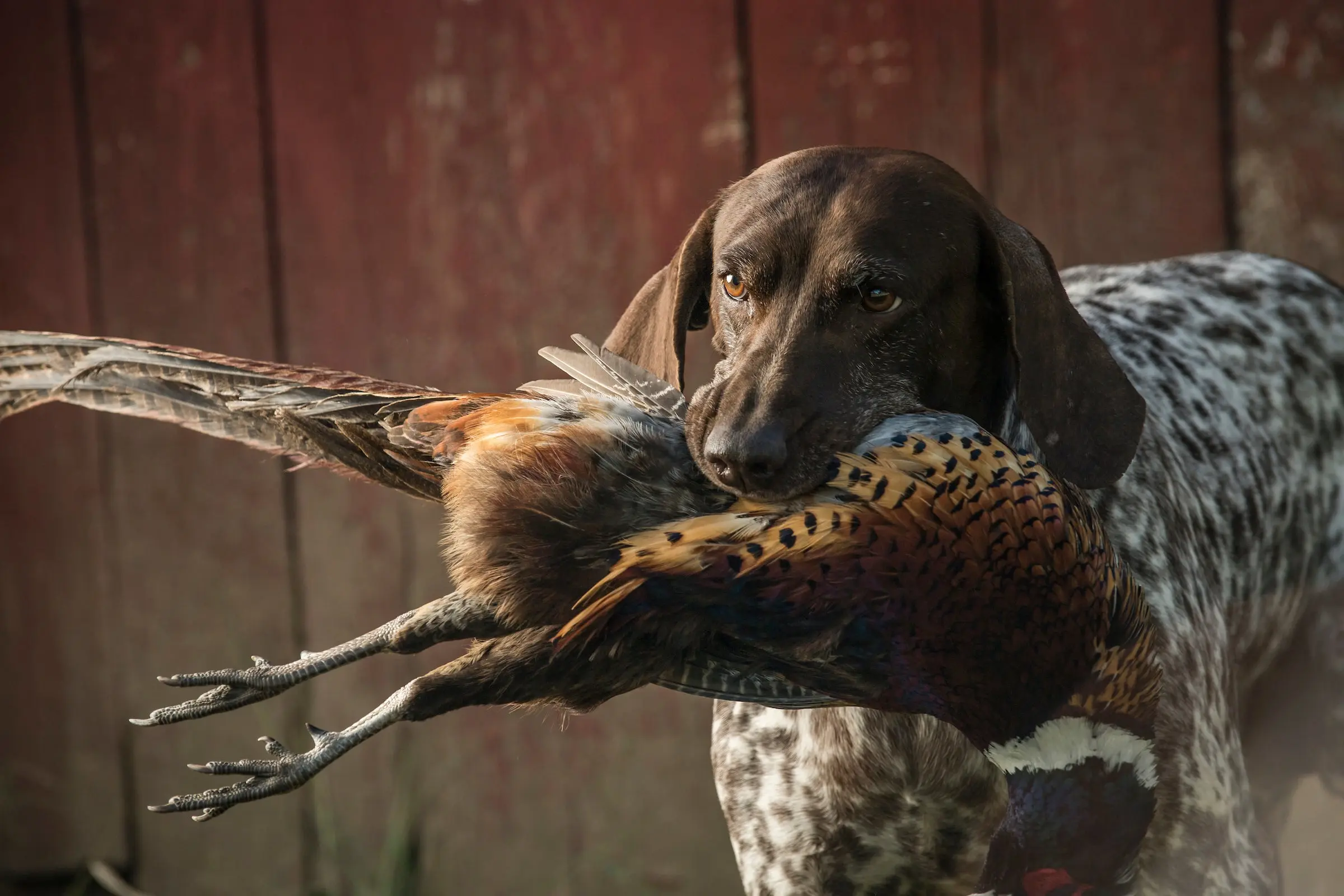
Basic obedience training is the foundation any dog needs to become a great hunter. John Hafner Photography
At this point, you might be thinking, Okay, when do we teach the dog how to hunt? You have been. Obedience training is the “wax on, wax off” part of training for hunting. Everything you want to in the field with your dog is built on a foundation of obedience and the eagerness to please you that you’ve instilled through repetition.
Once you’ve built this foundation, you can start moving on to in-the-field hunting skills. One of the first things I taught my German shorthair, Zeke, was quartering. The summer I brought him home, I started walking him on a check-cord (a 25-foot cord, wear gloves) in the back yard, and I’d let him go as far one way as he could, then say “hup” and turn, steering him back to cast the other way, teaching him to quarter in front of the gun. That was his first hunting lesson, and it taught him to work back and forth in a windshield-wiper pattern.
How to Teach “Fetch”
You can also start teaching your puppy to fetch. Most hunting dogs, especially retrievers, have a strong instinct to retrieve and carry things in their mouths. Start in a narrow space like a hallway so the pup has to come back to you, and toss a puppy bumper. Say “fetch” and let the dog go and get it. The hallway helps keep the dog coming back to you, not running off with the bumper. If you need to, put the dog on a check cord so you can guide it back to you. Then you can delay longer and longer before taking the bumper and offering the treat.
Remember that the bumper is yours. Keep it separate from the dog’s chew toys and only get it out for training. But do teach your dog to pick up all kinds of things, like leather gloves and brushes. You want a dog that will pick up anything you tell it to pick up. Some dogs don’t like the feel of feathers in their mouths. I have bought quail from preserves and kept dead pigeons in my freezer to thaw and throw for dogs to get them over this particular hump. Later, you may have to come back and do some form of learned or forced fetching later. For now, and during the dog’s first season, keep it all fun.
How to Teach “Whoa”
“Whoa” is an important command for a lot of reasons. It stops the dog immediately, which is key for safety and basic obedience, and it comes in handy if you have a pointing dog that’s trying to creep on sitting birds. One good way to teach it is with the check cord run around a post so the dog is facing you but can’t come closer. Then you simple say “whoa” just before the cord checks him up. Then you can release the cord and let it come to you for a treat or praise.
Take advantage of informal training opportunities too. I taught Zeke to whao by snubbing him on a leash and commanding “whoa” when I brought him into the house after he’d go out in his pen. I progressed to where I could stop him without the leash, and then we translated that into the field.
How to Teach “Place”
“Place” is essential for retrievers, and a useful command for any dog. The dog learns to sit in its place and stay there. The place itself can be anything: a square of carpet works to start with. Later it might be dog blind in a field, or a platform on a tree in flooded timber, or a patch of dirt by your side in a dove field. Lead your dog to the carpet square and step over it so the dog has to go onto the square, then reward it with a treat and say “place.” Let the dog stay there longer and longer. This lesson takes time and many repetitions. You might occasionally throw a bumper for the dog to let it learn that good things happen when it waits. Your goal is to get it to sit for extended periods wherever you choose when you command “place.”
Introduction to Water
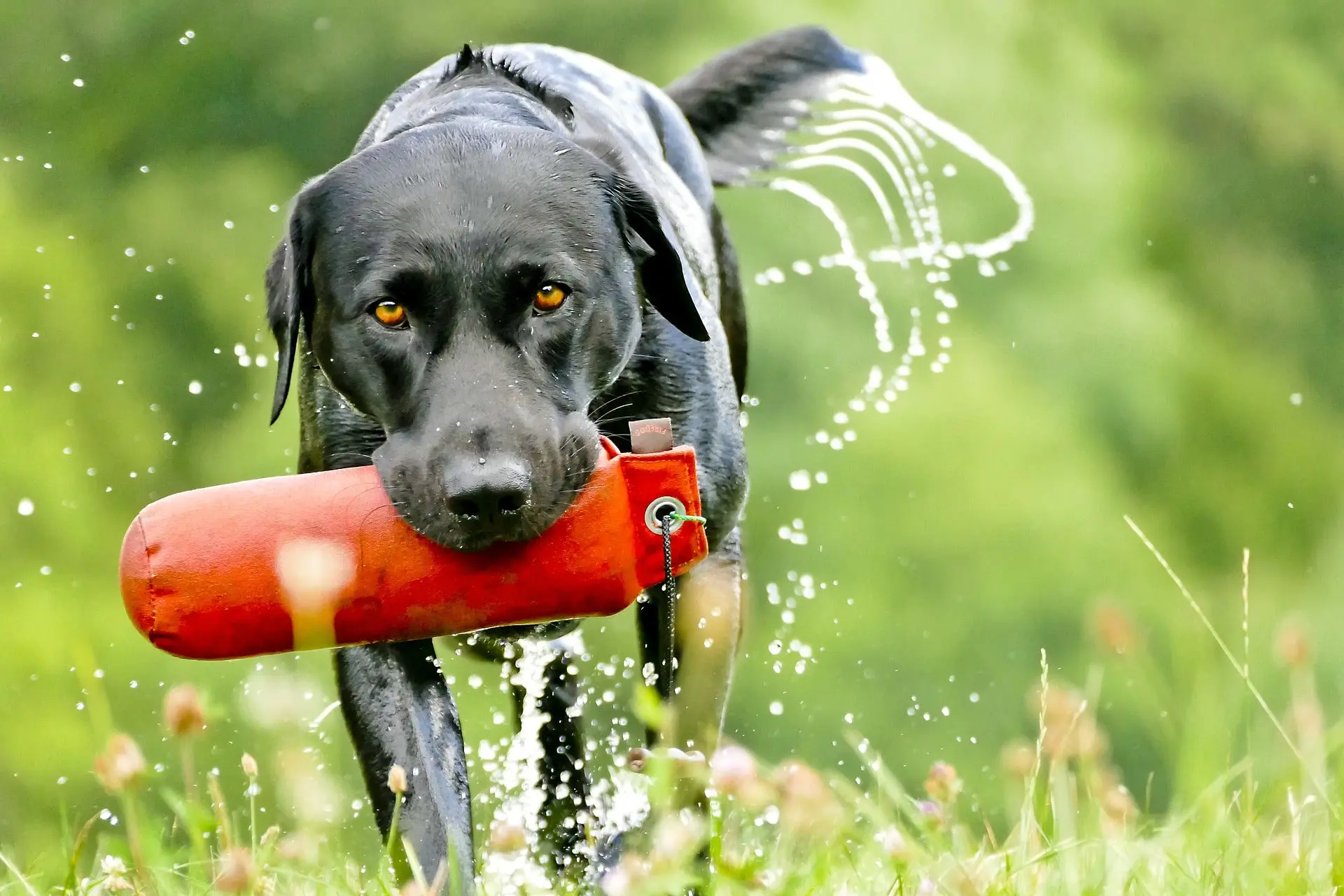
Don’t assume every hunting dog is going to love water. Take it slow at first. Gerd Maiss from Pixabay
Some people introduce puppies to water as early as 10 weeks. It’s a great summer activity as the dog can play for a long time in the water without overheating. But I have learned the hard way that you have to do it gradually if the dog is at all reluctant. You’ll be going into the water, too, so dress appropriately. Start in very shallow water. Bring toys, treats, keep it fun, and let the puppy run around in the water. Eventually—and it may not be the first lesson or the fifth lesson—you’ll be able to get the puppy to follow you into water where it has to swim, or to go after a retrieving bumper. Do not rush this. I made the mistake of trying to do too much too soon with my last dog, Jed, and he wouldn’t go into the water after that. Then one day at age 10 he surprised me by plunging off a steep bank to fetch a bird I shot that had fallen in a creek. You don’t want to wait 10 years for your pup to get over the trauma of being pushed too hard to swim.
**Related: The 10 Best Duck Hunting Dogs
**
Introduction to Live Birds
It takes birds to make a bird dog. That’s true, and daunting to those who don’t have access to birds. If your breeder is local, you might be able to train with them, as I did with Zeke. That first summer we drove up to the kennel several times for 20 minutes or so of work on pigeons in launchers, working Zeke on check cord until he was downwind of the birds, then making him hold point for a minute or two until we triggered the launcher. You might be able to train at a shooting preserve, too. If you don’t have access to pigeons or pen-raised birds, you’ll have to run your dog on wild birds, which can work, too, although it’s not a controlled situation.
Whether to Use an E-Collar
An E-collar
can be a great tool. It can also ruin a dog. It allows you to make immediate corrections, whether that be obeying a command in the field or not getting up on a kitchen counter. But as with everything, you need to proceed gradually. Start with the minimum amount of stimulation. Most collars have a tone setting, a vibrate setting, and levels of intensity. They all have their uses. You can use the tone followed by stimulation so the dog associates the two, then train with the tone only. I used a collar set to vibrate to stop Zeke from pulling on the leash when we walk about the block. I also have used a collar set to a higher intensity to break a dog from chasing deer. It only took one jolt when Ike started chasing. And because I said nothing, he associated the shock with the deer, and never chased again.
You certainly don’t need to use an E-collar if you prefer not to. But it can actually be safer for the dog to do so. My old shorthair Sam got hit by a car and that cured him from ever chasing cars or crossing roads again. But it would have been a lot easier and less painful to the dog had he learned it with a collar.
Introduction to the Gun
There are different ideas about how to introduce a dog to gunfire. It’s important to get it right, because a gun-shy dog is hard to cure and no use in the field. Some people shoot cap pistols or make a racket clanging pots and pans at feeding time. Others take their dog to the gun club and acclimate them by slowly getting closer to the firing line. To me, that approach has too much risk. You want the puppy to be distracted and excited when you shoot around it, and to associate guns with birds. I’ve had good success taking the dog into the field and shooting into the air as it flushes a bird and starts to chase. You can begin with a starer pistol and work your way up. It’s very important not to shoot directly over the dog, and even better if you have an assistant to shoot from a distance at first. I started that way, then I’d go out on my own and let Zeke find a bird. When he chased it, I’d shoot. The first time, he looked back at me, and I acted as if nothing had happened. After that he was fine.
The Reward: First Hunts with Your New Bird Dog
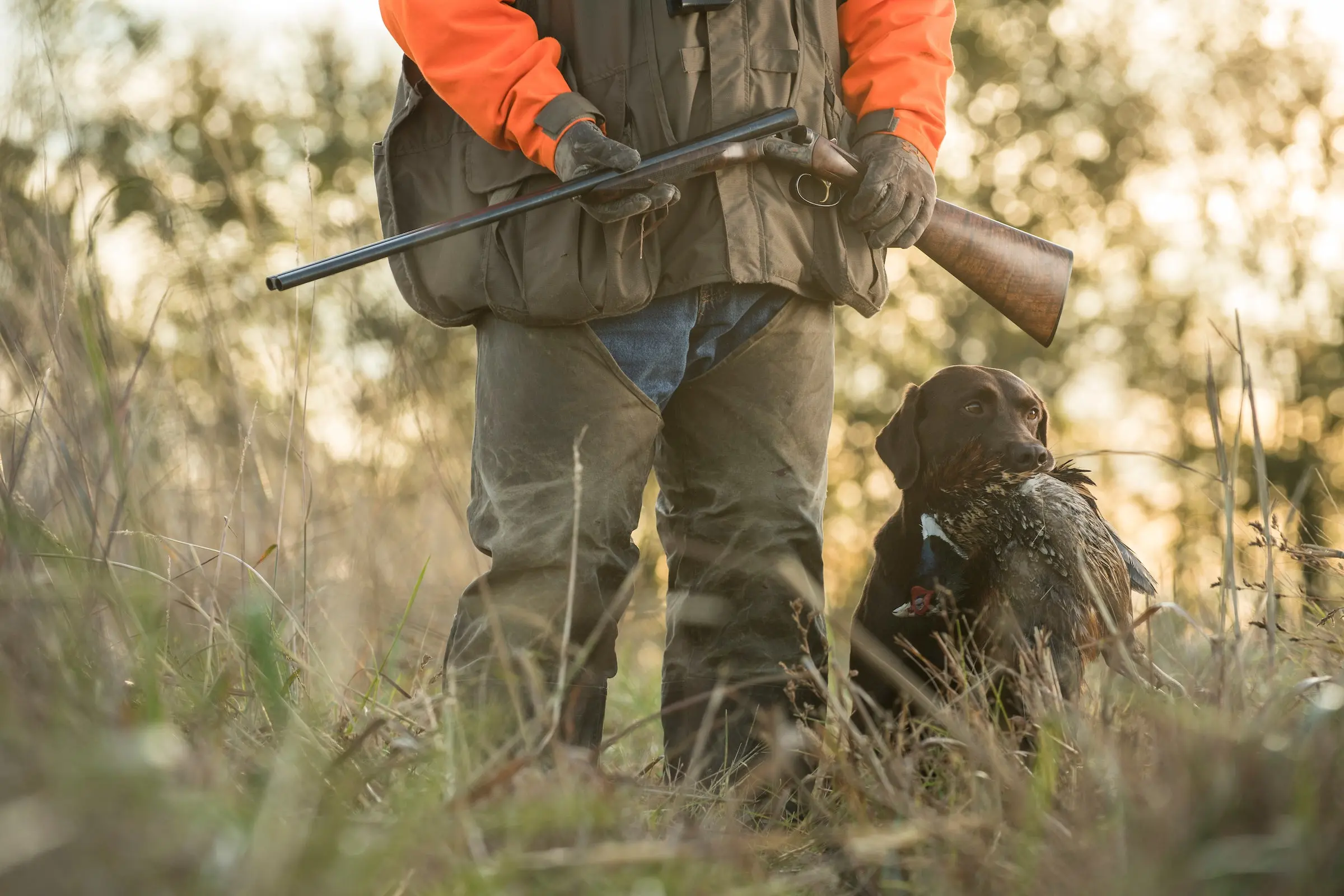
Expect to do more training that hunting during pup’s first season. But do savor the successes. John Hafner Photography
Your first hunts are about the dog, not about killing birds. You need to control the situation as much as possible. If your dog is a retriever and someone else can do the shooting, leave your gun at home so you can keep the dog from breaking, and you can concentrate on all the handling without the distraction of doing any shooting yourself. Avoid big parties and go with a trusted friend or two who understand that getting the dog a good start is more important than shooting a lot of birds. With a pointer or flusher, be careful that no one shoots directly over the dog and only reward the behavior you want, which means not shooting anything your pointing-dog puppy bumps or flushes. The flush and the excitement of a warm dead bird are powerful reinforcements, and if you reward bumping now because you want to shoot a bird, you’ll regret it later.
Don’t worry, though. The puppy season for any dog is not only a lot of fun, but your new sidekick will already be a hunter, and you’ll shoot plenty of birds even if you practice the proper restraint. All of my dogs’s puppy seasons have been great, and there’s the added reward of seeing the lights come on in their eyes as they find out what their life’s work will be. Enjoy that first season. It will be the start of a long, rewarding partnership.


